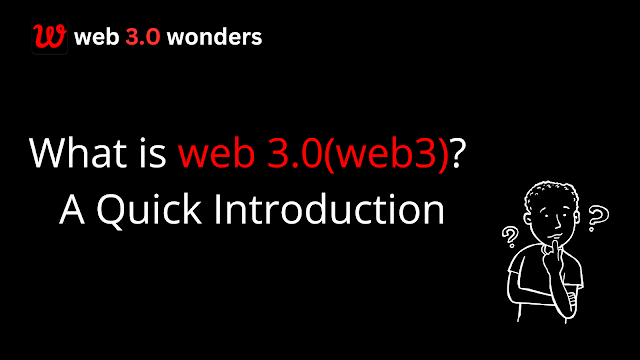Web3 is the next generation of the internet that emphasizes decentralization, enabling direct peer-to-peer interactions without relying on intermediaries. It leverages blockchain technology, fostering transparency, security, and user ownership of data and digital assets.
In this guide, you'll learn:
- What is Web 3.0 in simple words?
- Decentralization in Web3
- Interoperability in web3
- What is Tokenization?
- Governance in Web3
- What are the use cases of web3?
- What are the challenges of web3?
- What is the future of web3?
- Conclusion
What is Web 3.0 in simple words
Web3 represents the third generation of the World Wide Web, characterized by a decentralized and user-centric approach. Unlike Web1, which was primarily static, and Web2, dominated by social media and centralized platforms, Web3 embraces decentralization, empowering users and fostering collaboration.
Evolution from Web1 to Web3
To truly grasp the essence of Web3, it's essential to trace its roots back to Web1 and Web2. Web1 was the era of static web pages, limited interactivity, and one-way communication. Web2 brought about dynamic web, social media, and user-generated content. Now, Web3 is ushering in a new era where decentralization (decentralized web) and user empowerment reign supreme.
Key Concepts of Web3
Web3 is built on several key concepts, including decentralization, blockchain technology, and smart contracts. These concepts form the foundation of a digital landscape where trust is distributed, and users have greater control over their data and online interactions.
Decentralization in Web3
Peer-to-Peer Networks
Decentralization in Web3 is facilitated through peer-to-peer networks. Instead of relying on central authorities, data is distributed across a network of nodes, enhancing security and reducing the risk of a single point of failure.
Blockchain Technology
Blockchain, a decentralized and distributed ledger, plays a pivotal role in Web3. It ensures transparency, immutability, and trust in transactions, fostering a new level of digital trust among users.
Smart Contracts
Smart contracts are self-executing contracts with the terms of the agreement directly written into code. These contracts automate processes, eliminating the need for intermediaries and enhancing efficiency in transactions.
Interoperability in web3
Seamless Interaction of Decentralized Apps (DApps)
Web3 enables the seamless interaction of Decentralized Applications (DApps) across different platforms. This interoperability enhances user experience and opens new possibilities for innovation.
Role of Blockchain in Interoperability
Blockchain acts as the common language facilitating interoperability among various DApps. It ensures that different blockchain networks can communicate and share data effectively.
Benefits for Users and Businesses
Interoperability in Web3 benefits users by providing a unified experience and businesses by fostering collaboration and innovation. It breaks down silos, creating a more interconnected digital ecosystem.
What is Tokenization
Digital Assets on Web3
Tokenization involves converting real-world assets into digital tokens on the blockchain. Web3 facilitates the creation, transfer, and management of these digital assets in a secure and transparent manner.
Token Economy
Web3 introduces a token economy where these digital assets can be exchanged and traded. This decentralized economy disrupts traditional financial systems, offering new opportunities and challenges.
Impact on Traditional Financial Systems
The tokenization of assets challenges traditional financial systems by providing more accessible and efficient means of transferring value. This shift has profound implications for the future of finance.
Governance in Web3
Decentralized Autonomous Organizations (DAOs)
Web3 introduces Decentralized Autonomous Organizations (DAOs) as a novel approach to governance. DAOs operate without central control, allowing community members to participate in decision-making processes.
Community-Led Decision Making
The shift towards community-led decision-making ensures that stakeholders have a say in the development and evolution of platforms and protocols. This inclusive approach promotes transparency and fairness.
Ensuring Transparency and Fairness
Web3 governance mechanisms aim to ensure transparency and fairness by reducing the concentration of power. This aligns with the decentralized ethos of Web3, empowering individuals in the decision-making process.
What are the use cases of web3
Decentralized Finance (DeFi)
Web3 is a driving force behind Decentralized Finance (DeFi), revolutionizing traditional financial services. DeFi platforms enable users to access financial services without relying on traditional banks.
Non-Fungible Tokens (NFTs)
Non-Fungible Tokens (NFTs) are unique digital assets representing ownership of digital or physical items. Web3 provides the infrastructure for the creation, trading, and ownership of NFTs, transforming the art and gaming industries.
Social Media and Content Platforms
Web3 challenges the centralization of social media and content platforms. Decentralized alternatives empower users by giving them control over their data and content, fostering a more democratic digital space.
What are the challenges of web3
Scalability Issues
Web3 faces challenges related to scalability, as the growing user base strains blockchain networks. Addressing scalability concerns is crucial to ensuring the widespread adoption of Web3 technologies.
Regulatory Challenges
The decentralized nature of Web3 raises regulatory challenges, as existing frameworks may struggle to adapt. Striking a balance between innovation and compliance is essential for the sustainable growth of Web3.
Environmental Impact
The energy consumption of some blockchain networks raises environmental concerns. Addressing the environmental impact is crucial for the long-term viability of Web3 technologies.
What is the future of web3
Emerging Trends
Several trends are shaping the future of Web3, including the integration of Artificial Intelligence (AI), the rise of decentralized identity solutions, and the exploration of new consensus mechanisms.
Potential Innovations
Web3 holds the potential for groundbreaking innovations, such as the development of decentralized applications in various industries, the evolution of decentralized identity solutions, and the integration of AI to enhance user experiences.
Impact on Society and Technology
The widespread adoption of Web3 is set to reshape the relationship between technology and society. From democratizing access to financial services to redefining how we interact online, Web3 is at the forefront of a digital revolution.
Conclusion
In conclusion, Web3 represents a paradigm shift in the digital landscape, ushering in an era of decentralization, transparency, and user empowerment. As it continues to evolve, addressing challenges and fostering innovation will be key to unlocking its full potential.





